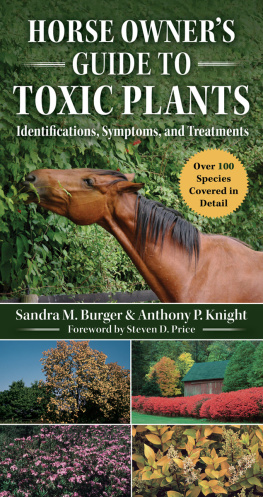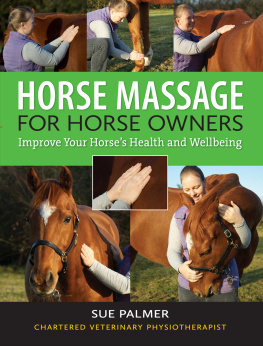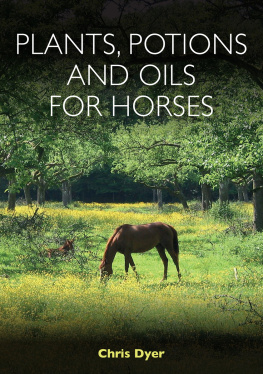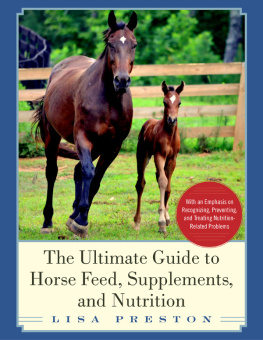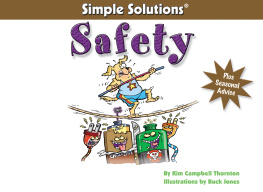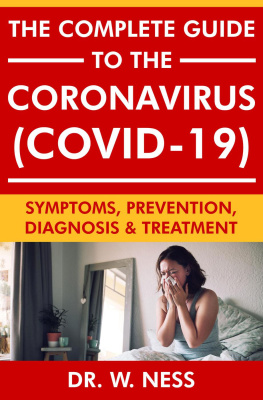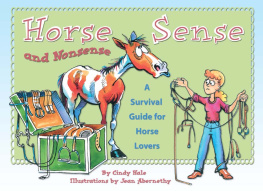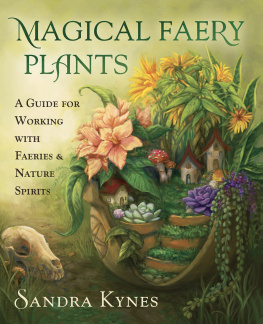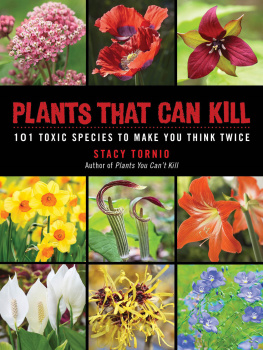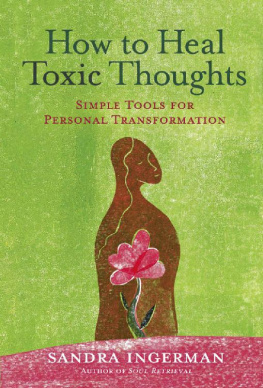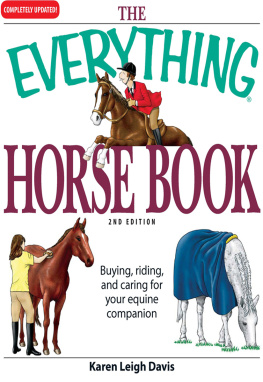Sandra McQuinn - Horse Owners Guide to Toxic Plants: Identifications, Symptoms, and Treatments
Here you can read online Sandra McQuinn - Horse Owners Guide to Toxic Plants: Identifications, Symptoms, and Treatments full text of the book (entire story) in english for free. Download pdf and epub, get meaning, cover and reviews about this ebook. year: 2020, publisher: Skyhorse, genre: Children. Description of the work, (preface) as well as reviews are available. Best literature library LitArk.com created for fans of good reading and offers a wide selection of genres:
Romance novel
Science fiction
Adventure
Detective
Science
History
Home and family
Prose
Art
Politics
Computer
Non-fiction
Religion
Business
Children
Humor
Choose a favorite category and find really read worthwhile books. Enjoy immersion in the world of imagination, feel the emotions of the characters or learn something new for yourself, make an fascinating discovery.
- Book:Horse Owners Guide to Toxic Plants: Identifications, Symptoms, and Treatments
- Author:
- Publisher:Skyhorse
- Genre:
- Year:2020
- Rating:4 / 5
- Favourites:Add to favourites
- Your mark:
- 80
- 1
- 2
- 3
- 4
- 5
Horse Owners Guide to Toxic Plants: Identifications, Symptoms, and Treatments: summary, description and annotation
We offer to read an annotation, description, summary or preface (depends on what the author of the book "Horse Owners Guide to Toxic Plants: Identifications, Symptoms, and Treatments" wrote himself). If you haven't found the necessary information about the book — write in the comments, we will try to find it.
Sandra McQuinn: author's other books
Who wrote Horse Owners Guide to Toxic Plants: Identifications, Symptoms, and Treatments? Find out the surname, the name of the author of the book and a list of all author's works by series.
Horse Owners Guide to Toxic Plants: Identifications, Symptoms, and Treatments — read online for free the complete book (whole text) full work
Below is the text of the book, divided by pages. System saving the place of the last page read, allows you to conveniently read the book "Horse Owners Guide to Toxic Plants: Identifications, Symptoms, and Treatments" online for free, without having to search again every time where you left off. Put a bookmark, and you can go to the page where you finished reading at any time.
Font size:
Interval:
Bookmark:


 Copyright 1996, 2020 by Sandra McQuinn Foreword 2020 by Skyhorse Publishing All rights reserved. No part of this book may be reproduced in any manner without the express written consent of the publisher, except in the case of brief excerpts in critical reviews or articles. All inquiries should be addressed to Skyhorse Publishing, 307 West 36th Street, 11th Floor, New York, NY 10018. Skyhorse Publishing books may be purchased in bulk at special discounts for sales promotion, corporate gifts, fund-raising, or educational purposes. Special editions can also be created to specifications. For details, contact the Special Sales Department, Skyhorse Publishing, 307 West 36th Street, 11th Floor, New York, NY 10018 or .
Copyright 1996, 2020 by Sandra McQuinn Foreword 2020 by Skyhorse Publishing All rights reserved. No part of this book may be reproduced in any manner without the express written consent of the publisher, except in the case of brief excerpts in critical reviews or articles. All inquiries should be addressed to Skyhorse Publishing, 307 West 36th Street, 11th Floor, New York, NY 10018. Skyhorse Publishing books may be purchased in bulk at special discounts for sales promotion, corporate gifts, fund-raising, or educational purposes. Special editions can also be created to specifications. For details, contact the Special Sales Department, Skyhorse Publishing, 307 West 36th Street, 11th Floor, New York, NY 10018 or .
Skyhorse and Skyhorse Publishing are registered trademarks of Skyhorse Publishing, Inc., a Delaware corporation. Visit our website at www.skyhorsepublishing.com. 10 9 8 7 6 5 4 3 2 1 Library of Congress Cataloging-in-Publication Data is available on file. Cover design by Daniel Brount Cover image credit: iStockphoto.com Book interior designed by Greenboam & Company, Ossining, New York; maps by Robert Greenboam. Pen-and-ink line drawings reprinted with the permission of Scribner, an imprint of Simon & Schuster, from Poisonous Plants of the United States by Walter Conrad Muenscher. Muenscher. Muenscher.
Print ISBN: 978-1-5107-4165-2 Ebook ISBN: 978-1-5107-4167-6 Printed in China Foreword D uring the spring season several years ago, four horses on a Western ranch began to lose weight and suffer from photosensitivity and neurological distress. A thorough physical and blood-work exam revealed extensive liver disease that a liver biopsy confirmed. Alkaloids in the liver were the variety typically found in such weeds as tansy ragwort, fiddle neck, and rattle pod. None of these plants were found in the horses pasture. However, when the horses owner opened a bale of hay from the supply animals had been fed throughout the winter, he found broad, hairy leaves measuring eight inches to a foot in length. These were the culprit: a noxious weed called hounds tongue that contains significant quantities of the alkaloids in question even when dried in hay.
These alkaloids have a cumulative effect on the liver, and after eating the contaminated hay over the winter, the horses developed chronic irreversible liver disease. None of the four horses was able to recover from liver failure, and all had to be euthanized. The moral of this sad tale is clear if not obvious: just because potentially fatal foliage doesnt grow in a paddock or pasture does not made the occupants of that field immune to the plants effects. The widespread belief that that equine instinct causes horses to avoid poisonous plants is a pernicious piece of folk wisdom that should be filed under old wives tales. Hungry horses do not heed warnings about avoiding poisonous plants nor do they automatically eat around tainted portions in their feed or pasturage. If good quality forage is plentiful in the pasture, horses will avoid most poisonous plants, but in the absence of better foodstuff, such as during a prolonged drought or when pastures are overgrazed, horses will be forced to ingest dangerous plants.
It is therefore essential that owners, barn managers, and riders and drivers become able to identify poisonous plants and take pains to keep them away from their horses and poniesand visa-versa. Thats not an easy task. A very wide variety of plants contains chemical compounds capable of poisoning. The effects of these toxins can range from mild irritation and weight loss to colic, organ failure, and other possible or inevitable causes of death. Depending on the degree of plant toxicity, poisoning can occur due to a single mouthful or longer and more repeated contact. Then too, because it can resemble other physiological problems, plant poisoning is often difficult to diagnose and distinguish from other veterinary medical issues.
We are told that an ounce of prevention is worth a pound of cure. Make that a ton of prevention, and you will understand the importance of nipping toxic plants on your property even before the bud. As this book so wisely stresses, learning to recognize poisonous plants and eliminating their presence is essential. Even if the idea of inspecting a large expanse of pasture and woodland seems overwhelming, theres no better way to discover the enemy and decide the best methods of combat, whether by removal or exclusion by means of fencing or, if feasible, selecting a less dangerous pasture. It is also important to inspect areas around a pasture. Many such areas contain poisonous trees and shrubs; any broken branches that fall or are blown into pasturage present toxic dangers.
It bears repeating that education is the key to survival. In that regard, this essential field guide is both a valuable first step and an easily accessible ongoing reference to avoiding and otherwise contending with the dangers of plant toxicity and the heartbreaks that can ensue (with regard to such sad consequences, the authors initial chapter about the loss of her beloved horse Hans is moving testimony). Study this books sound advice and equally useful and profuse illustrations, and discuss its contents with your veterinarian, county agent or other landuse resource, and other horse and pony owners and caregivers. Horse Owners Field Guide to Toxic Plants belongs in every horsemans library and tackroom. Steven D. Price Editorial Director The Whole Horse Catalog Acknowledgments M y first acknowledgment is to my late grandfather, Edward A.
Smith, who always supported and encouraged all of my horse endeavors. I only wish he could have been a part of this one. Special thanks to my mother, Suzanne McQuinn, for her love and support, and for editing the draft copy of the book. To my late grandmother, Lavera Smith, whose excitement about the project helped me to finish. And to the late Dr. Thomerson, Dr.
Quatro Patterson, and Dr. Scott Chapman of Kerrville, Dr. Steve Sells and Dr. Conrad Nightengale of Bandera, thank you all for your emergency assistance for the many rescue horses that crossed our paths, and for being supportive of me for many years. Sandra McQuinn T he publisher wishes to thank Penny OPrey, project editor; Bob Greenboam, graphic designer; Chris and Dan Diorio, fact checkers and botany researchers; Zoe Moffatt, photo researcher; Chris Heath, proofreader; Judith Hancock, indexer; Peter and Paul Calta, image setters; Rhona Johnson, editor; Michelle Kenneson; Cornell Universitys Poisonous Plants Garden and Cornell Plantations, Ithaca, New York; the United States Department of Agriculture Photo Archives in Washington, D.C.; Dr. Lynn James, director of the USDA Poisonous Plants Laboratory in Logan, Utah; the Ossining, New York, Public Library and the Westchester County, New York, Library System; the New York Botanical Garden and Library; the Maryknoll Seminary Library, Maryknoll, New York; and Dr.
Eleanor Kellon, VMD, for her invaluable advice. Dedicated
in loving memory
to
Hans Run free my love,
with the wind
in your beautiful mane.
You were my best friend.
I will miss you always. Contents Hanss Story I am writing this book in the hope that it will prevent others from having to endure the total devastation I have experienced. I purchased Hans at an auction in Texas when he was just a weanling. His lineage was of working stock horse from South Dakota, and he was a fancy, stout, dun colt. I registered him with the American Quarter Horse Association under the name I Dun Well as he was very quick to learn about haltering and standing to be groomed.
Font size:
Interval:
Bookmark:
Similar books «Horse Owners Guide to Toxic Plants: Identifications, Symptoms, and Treatments»
Look at similar books to Horse Owners Guide to Toxic Plants: Identifications, Symptoms, and Treatments. We have selected literature similar in name and meaning in the hope of providing readers with more options to find new, interesting, not yet read works.
Discussion, reviews of the book Horse Owners Guide to Toxic Plants: Identifications, Symptoms, and Treatments and just readers' own opinions. Leave your comments, write what you think about the work, its meaning or the main characters. Specify what exactly you liked and what you didn't like, and why you think so.

